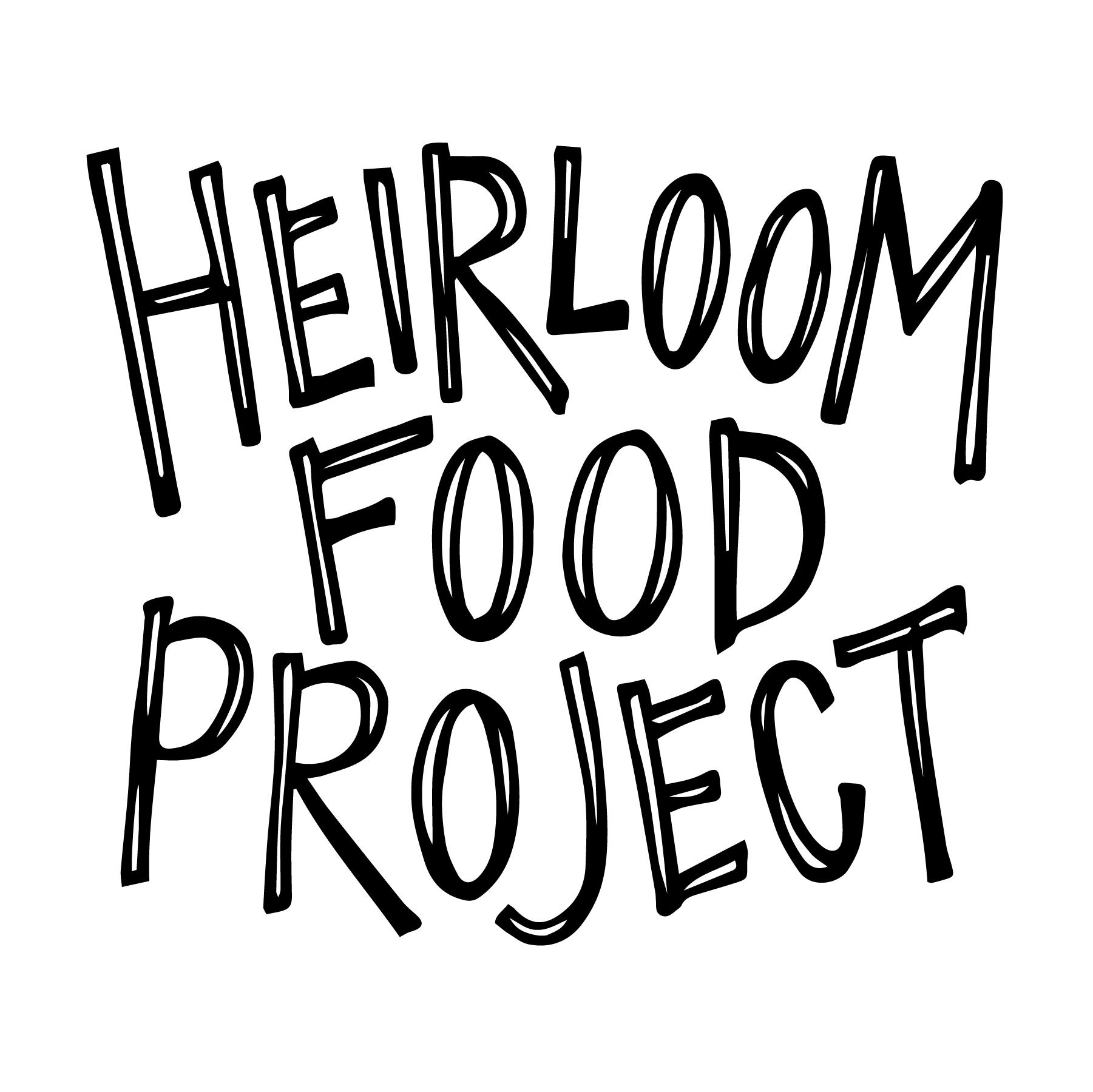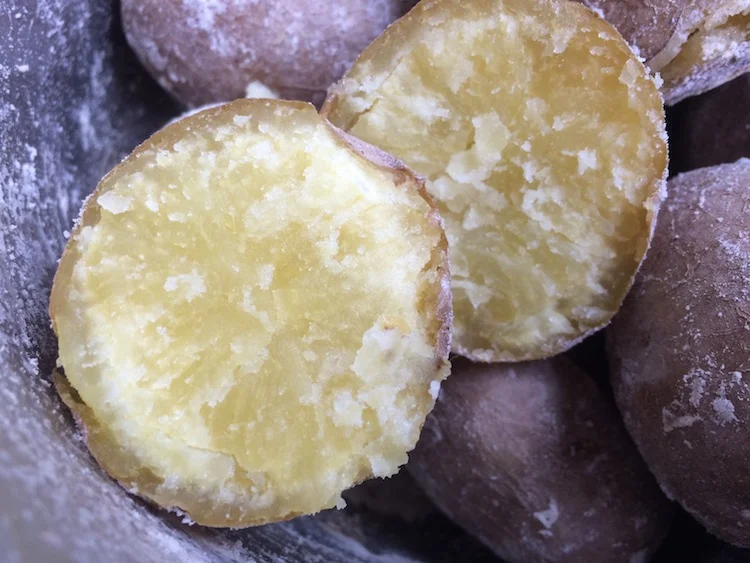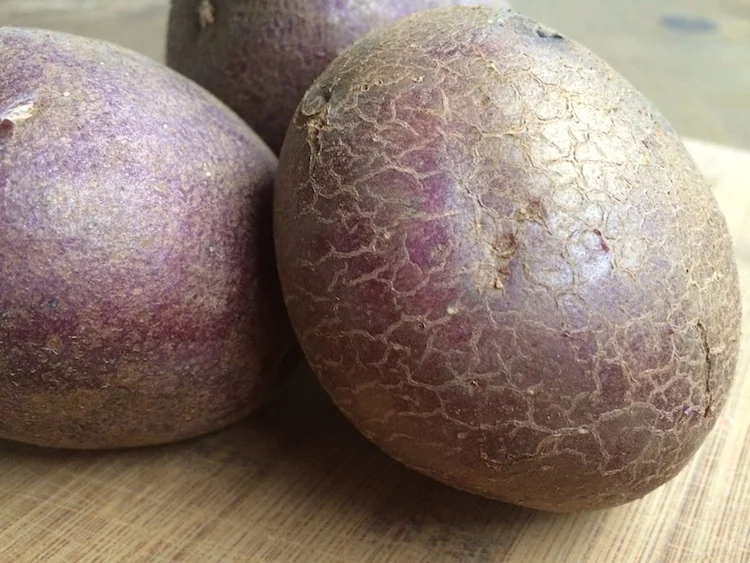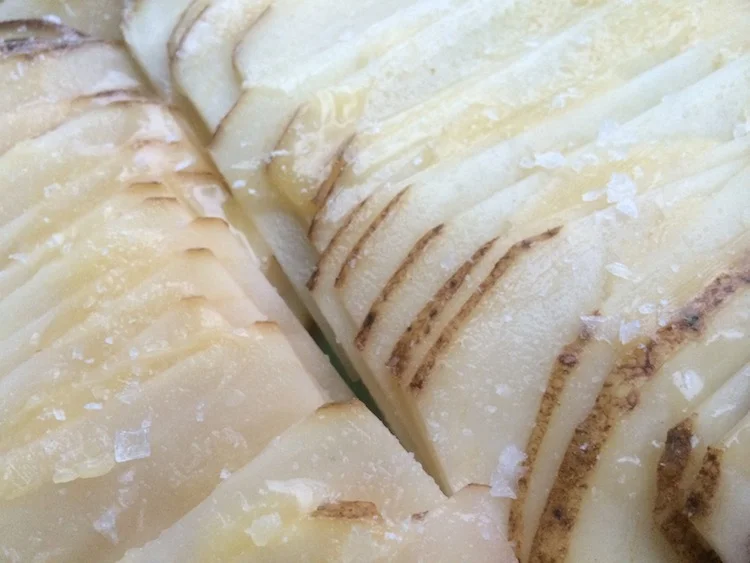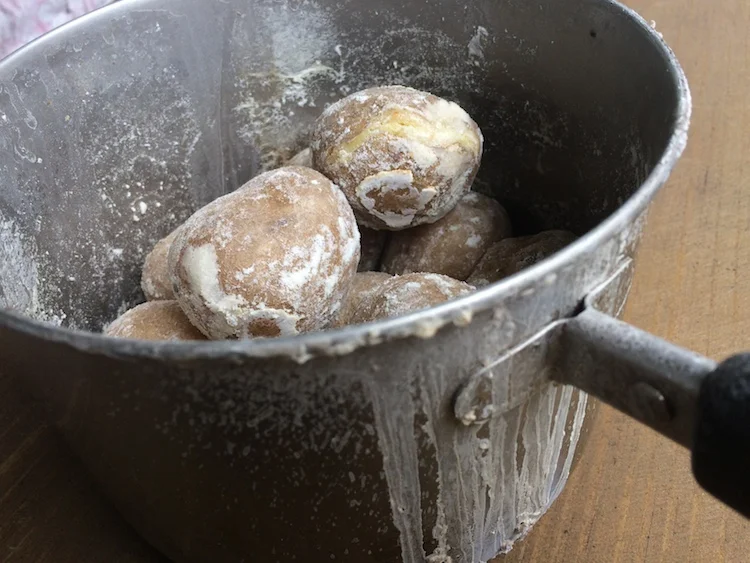The Potato: Seek Out Many Stories
If I had a ‘before’ and ‘after’ picture for the appreciation I gained for the potato this month, the difference would be dramatic.
Before, when I thought about potatoes, this is what came to mind: french fries, Lay’s potato chips, the starch that accompanies a protein and a vegetable for a complete meal according to dietary guidelines, mayonnaise-y potato salad, and mashed potatoes (with gravy on Thanksgiving; with pork, sauerkraut, and peas for good luck on New Year’s).
Specific memories came to mind, too.
There were the baked potatoes loaded with butter, sour cream, and chives that we ate on weeknights in between volleyball practice and homework (sometimes cooked in the microwave, which seemed to be a miracle to me). I used to scrape out all the white fluff, leaving the skins behind.
My dad would throw potato wedges, carrots, and a chicken in the slow cooker for another weeknight staple. Those potatoes were waxy and tasted so good from soaking in juice all day long. I remember quartering pounds and pounds of red skinned potatoes for big parties at my first job. My family loved it when I made the same garlic-happy recipe at home.
I’ll never forget the smoky patatas bravas I had at a tiny Cincinnati restaurant that poured so much heart into what they did that they could only stand to be open for a year. I remember stirring potato flakes into boiling water on the camp stove while backpacking in a damp forest and how good that warm, filling meal tasted on the trail.
When I was 13, I visited the Irish Hunger Memorial in New York City. Fourteen years later, I visited again, this time with a bit more solemn awareness.
I remember the many boiled potatoes with brown sauce I had on my first trip to Denmark to meet my in-laws. The Danes easily slid off the skins of cooked potatoes with a butter knife and practiced hands while I clumsily burned my fingers on my own.
Potatoes have always been there. Sometimes, they grabbed my attention. Mostly, I ate them without second thought.
Then, I read a book that cracked open my whole potato world.
It’s called Potato: a history of the propitious esculent by John Reader, and it made me realize that all of my memories and connections tell only one story about the potato — one that is largely European and dismisses the idea of the potato as a nutritious food.
Reader’s book took me back thousands of years to the Andes, the long South American mountain range that I’d mostly associated with the chocolate after-dinner mints from my midwestern childhood.
With my one-track, Euro-centric view of the potato, how often did I think of the Andes in conjunction with the spud? Rarely, if ever. As it turns out, we potato eaters owe an enormous amount of gratitude to the indigenous Andean people who cultivated the bitter toxins out of the potato so that it could become a society-saving food.
High up in the Andes mountains — 3,000 meters and above to be exact — is where 36 percent of Peru’s population (10 million people) currently call home. Most are Quechua descendants of the hunter gatherers who first settled there 12,000 years ago. These are the people who created the Inca empire and then “were cruelly reduced to less than 10 per cent of their number by the Spanish conquest and the diseases it introduced,” writes Reader.
These are also the people who gave us the potato. According to Reader, this process began about 8,000 years ago:
“In the regions of Peru and Bolivia that border Lake Titicaca… people began to manipulate the wild potato…The motivation is a complete mystery. The tubers of wild potatoes are generally small, bitter to the taste and contain potentially poisonous levels of glycoalkoids. Why would people have bothered? But bother they did, and human ingenuity working with the plant’s adaptability eventually produced not one but seven cultivated species of potato.”
Since then, over 1,000 potato varieties have been named by Andean farmers, with some 400 distinct varieties actively grown. They were given names for their size, shape, and color. In the local Quechua language, a few of those names include “Waka qallu—cow’s tongue; Quwi sullu—guinea pig fetus; Puka pepino—red cucumber; and Papa Ilunchuy waqachi—the potato that makes the bride weep because it is so difficult to peel.”
The potato provided a key source of nutrition in the high Andes; in fact, it was entirely essential to their survival. When the potato was introduced to other cultures in far off lands, it was so nourishing that population growth spurts in those places can be directly attributed to its adoption.
According to Reader, potatoes yielded up to four times more calories than grain — the mainstay of seventeenth-century European diets — from the same amount of land. Mixed with the milk of one cow, those potatoes could keep a poor, rural family in good health for a year.
I could hardly have been more wrong when I dismissed them as an insubstantial food. Potatoes are a full package of carbohydrate and protein, along with many vitamins and minerals. The potato is so high in vitamin C that “when men were dying of scurvy during the Klondike gold rush, potatoes sold for their weight in gold,” says Reader.
From the time of the Spanish colonization of South America in the 1500s up through the 1800s, the potato spread throughout the world. It was met with initial resistance, especially in Europe where it was believed to cause leprosy, was banned by priests because it wasn’t in the Bible, and was not easily made into bread. After people began realizing its benefits (and ran out of other options), they adopted it. “Today,” Reader writes, “the potato is grown in 149 countries from latitudes 65 degrees north to 50 degrees south, from sea level to more than 4,000 metres, and has become the world’s fourth most important food crop (after wheat, maize and rice).”
Being the world’s fourth most important food crop is an important gig. You’ve gotta be dependable. You’ve gotta be strong. Unfortunately, this is where our common potato isn’t doing so well.
Of the seven species originally cultivated in the Andes, all the potato varieties now grown outside that region are derived from just one. That means that if a disease takes down one field, it can also take down another and another, wiping out much of our fourth most important food.
The situation is so fragile that we spend $2 billion a year protecting the world’s potato crop, according to Reader.
A single species. A single story.
With these thoughts swirling, I recalled a TED Talk I’ve seen many times. It’s called The Danger of a Single Story by Chimamanda Ngozi Adichie. In it, she recounts the books she read as a child about white, blue-eyed characters who played in the snow and ate apples. When she started writing stories of her own, they were about similar characters. But…she’d never been outside Nigeria, had never seen snow, and ate mangoes instead of apples. Adichie says, “What this demonstrates, I think, is how impressionable and vulnerable we are in the face of a story.”
Stories matter. Adichie continues: “I’ve always felt that it is impossible to engage properly with a place or a person without engaging with all of the stories of that place and that person.” The goal of this pursuit is to find “what the Nigerian writer Chinua Achebe calls ‘a balance of stories.’”
Are you connecting the same dots that I am?
Just as a single species of potato, bred over and over again can leave us vulnerable, so, too, can a single story, told over and over again. We need story diversity just like we need biodiversity.
The single story I had formed about the potato left out the indigenous Andeans and the value of their nutritious gift to the world. It was one small sliver of the whole picture.
When I read this book, I was flooded with additional stories — ones of survival, exploitation, ingenuity, suffering, and growth. Now, I am eating potatoes with newfound gratitude. The potato is no longer something I consume without second thought. I recognize their miracle, their importance, and their original cultivators. With the knowledge of these stories, I have a chance to honor all of that. The experience is full. The potatoes taste better.
Practice this in your own kitchen: Expand your potato repertoire
For me, learning a new cooking technique is like learning a new story. Each ingredient and each step offers information about that food culture from which it came. If you’re like me and you’ve stuck to a few of the same potato preparations for most of your cooking life, I invite you to try something different.
Here are a few ideas to get you started:
ñoquis (or gnocchi), the intersection of Andean potatoes and Italian technique that has become a very special dish for Argentina — in fact, the 29th of every month is dedicated to ñoquis
Simple salted potatoes or papas chorreadas from Colombian blogger Erica Dinho (I tried the salted potatoes myself; see picture above)
Boiled potatoes with Irish butter
A layered potato galette or potato dominoes from Patagonian chef Francis Mallman, who has an excellent episode on Chef’s Table on Netflix if you’re into that kinda thing
I challenge you to seek out many stories — about the places you go, the people you meet, and the foods you eat — to always be expanding upon what you know. I hope that the new stories will add a fullness to your experience as an eater and as a citizen of this world.
----------
Heirloom Food Stories aim to connect you to beauty, wisdom, and intuition in your kitchen. Each month we’ll deeply explore one fruit or vegetable, so we can know the whole stories—the joys, hardships, and curiosities—behind the foods on our plates.
